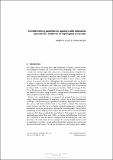Complementing quantitative typology with behavioral approaches: Evidence for typological universals
Author(s)
Jaeger, T. Florian; Tily, Harry J.
DownloadTily-2011-Complementing quanti.pdf (1.229Mb)
PUBLISHER_POLICY
Publisher Policy
Article is made available in accordance with the publisher's policy and may be subject to US copyright law. Please refer to the publisher's site for terms of use.
Terms of use
Metadata
Show full item recordAbstract
Two main classes of theory have been advanced to explain correlations between linguistic features like those observed by Greenberg (1963). arbitrary constraint theories argue that certain sets of features patterm together because they have a single underlying cause in the innate language faculty (e.g., the Principles and Parameters program; see Chomsky & Lasnik 1993). functional theories argue that languages are less likely to have certain combinations of properties because, although possible in principle, they are harder to learn or to process, or less suitable for efficient communication (Hockett 1960, Bates & MacWhinney 1989, Hawkins 2004, Dryer 2007, Christiansen & Chater 2008; for further discussion see Hawkins 2007 and Jaeger & Tily 2011). The failure of Dunn, Greenhill, Levinson & Gray (2011) to find systematic feature correlations using their novel computational phylogenetic methods calls into question both of these classes of theory.
Date issued
2011-11Department
Massachusetts Institute of Technology. Department of Brain and Cognitive SciencesJournal
Linguistic Typology
Publisher
Walter de Gruyter
Citation
Tily, Harry, and T. Florian Jaeger. “Complementing Quantitative Typology with Behavioral Approaches: Evidence for Typological Universals.” Linguistic Typology 15, no. 2 (January 2011). © 2011 Walter de Gruyter
Version: Final published version
ISSN
1430-0532
1613-415X